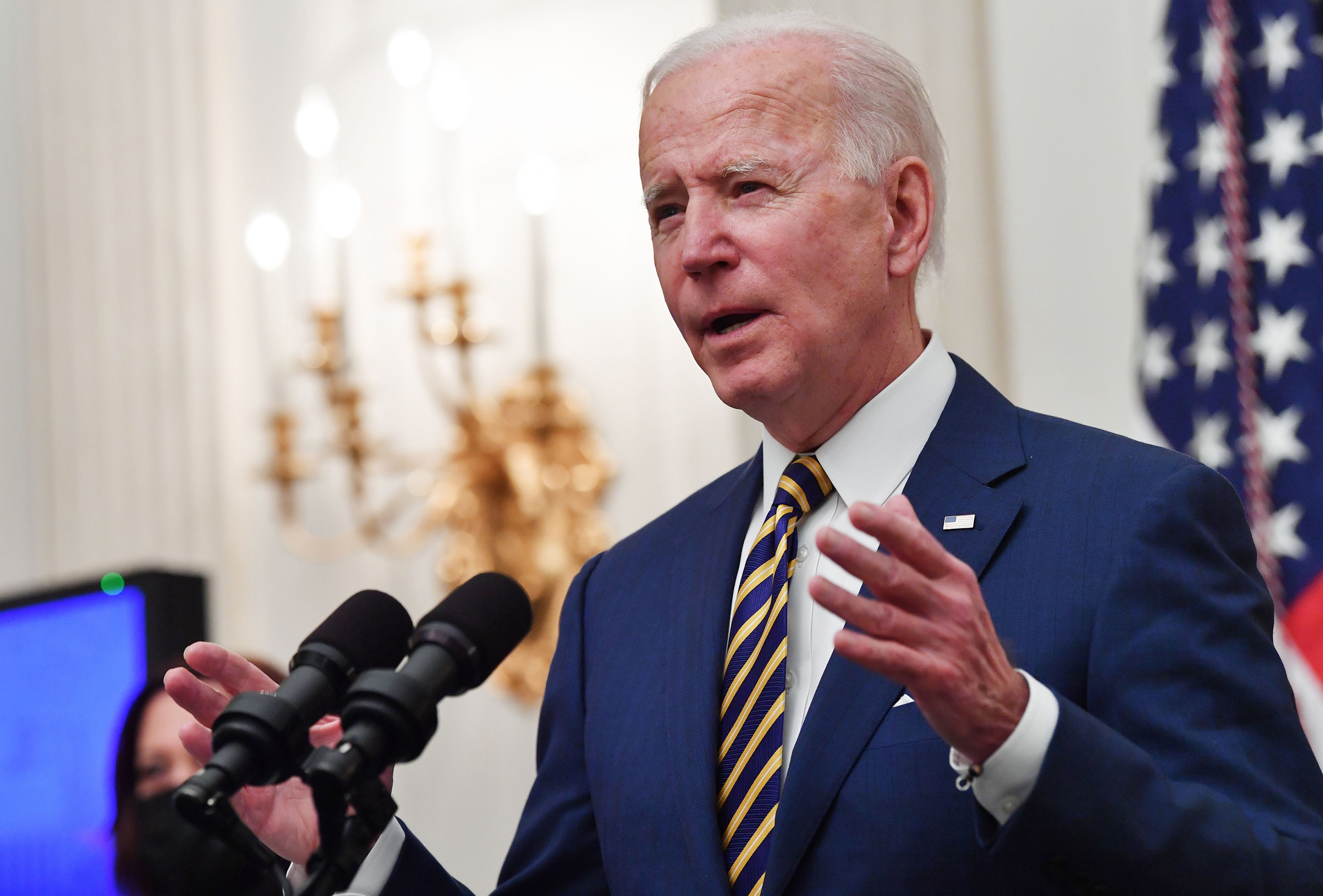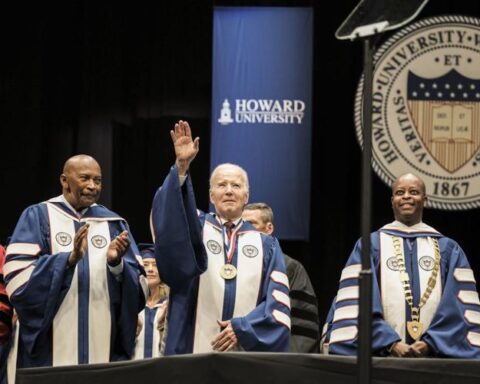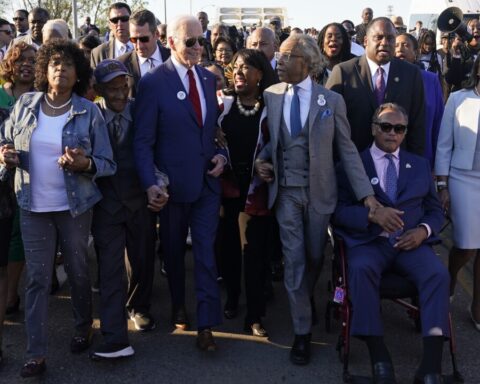The light at the end of the tunnel may be the fireworks bursting in air on the Fourth of July.
President Joe Biden on Thursday offered Americans the tantalizing hope of a return to an all but forgotten pre-pandemic normalcy within months, escalating the “war footing” on which he has placed the nation to beat the virus that has caused the worst domestic crisis in generations.
In his first prime-time address, Biden shouldered the theatricality, responsibility and pastoral nature of the presidency as never before, laying down a personal challenge to every citizen of a deeply polarized and grieving nation to buckle down to fight the virus and get vaccinated as soon as it is their turn.
The speech represented yet another stark break from the histrionics, boastfulness and lies of his predecessor, ex-President Donald Trump. Biden’s evocation of an opening of the country was based in science, an in-depth strategy that is rooted in reasonable expectations of achievable results rather than the illusory and politically motivated predictions that Trump often made.
Biden vowed to do his part as President to restore confidence in government, acknowledging that faith in federal institutions had been shattered by the previous administration’s disastrous response to the pandemic. As part of his effort to ease the nation back toward normal life, Biden announced that he was directing all states, tribes and territories to make all adults 18 and older eligible to be vaccinated by May 1, stating his administration would build out the infrastructure of clinics, vaccine doses and medical staff to make that prospect real. But he also asked the American people to do their part.
“I will not relent until we beat this virus. But I need you, the American people. I need you, I need every American, to do their part,” Biden said. “I need you to get vaccinated when it’s your turn and when you can find an opportunity. And to help your family, your friends, your neighbors get vaccinated as well. Because here’s the point, if we do all this, if we do our part, if we do this together — by July the Fourth, there’s a good chance you, your family and friends will be able to get together in your backyard or your neighborhood and have a cookout and a barbecue and celebrate Independence Day. … After this long hard year, that will make this Independence Day something truly special.”
Biden’s decision to raise the prospect of a return to normal life represented an attempt to persuade millions of Americans to overcome their skepticism about taking the vaccine. It was also an implicit acknowledgment of the exhaustion and impatience about the constraints of social distancing, the disruption of family life and the way restrictive measures have crippled the nation’s economy.
He appears to hope that setting a date for opening the country will convince citizens to stick with restrictions and sensible behavior for just a little longer, potentially saving tens of thousands of lives in the process. But by establishing a target date, he is also creating a bar against which his administration will be judged. The pandemic has repeatedly undermined predictions by top government officials who want to impose their own timetable on a pernicious and unpredictable virus, and he acknowledged that uncertainty in his address.
“This is fight is far from over,” Biden said. “July 4 with your loved ones is the goal. But a goal — a lot can happen, conditions can change. The scientists have made it clear that things may get worse again as the new variants of the virus spread.”
The President’s address doubled as a forum to build his own political momentum hours after he had signed into law a $1.9 trillion Covid relief package that represents the most targeted government effort to fight poverty in decades. But he also sought to show humanity distilled from a lifetime of personal loss by eulogizing the loss of life. He pulled a card from his pocket tallying American lives lost, which he carries with him each day. He also attempted to convey to Americans that he understands the trauma experienced by those who survived or did not get sick, referencing the crushed dreams of those who lost their jobs, homes, hope, weddings, graduations and first dates and family reunions.
“We all lost something, a collective suffering, a collective sacrifice — a year filled with the loss of life and the loss of living for all of us,” Biden said, almost leading a moment of national catharsis.
He then sought to enlist the national resolve brewed from adversity to create a sense of common, unified, national purpose to finally haul the country out of the darkness of the pandemic into the light of a better future.
His speech, in the East Room of the White House, was in the tradition of presidents using the unique bully pulpit of the office to galvanize a huge, united national effort, from a commander in chief who has spent decades observing his predecessors at close quarters.
His individual challenge to every American recalled the galvanizing confidence and optimism of President Franklin Roosevelt, who took office at a perilous moment of the Great Depression. The carrot of a date by which all adult Americans can become eligible for the vaccine comes as 1 in 10 citizens are fully vaccinated. But as more people get their doses, impatience is rising among those who are still waiting and want to get it.
Biden was not just laying down a challenge to states — but also to his own government, which must now provide the building blocks to states to carry out his orders. His speech came halfway through his first symbolic 100 days in office and exactly a year since the country started shutting down, as an NBA game was canceled after a positive test and actor Tom Hanks announced he had the virus.
Biden’s address to the nation also unfolded against the backdrop of a flurry of orders by mostly Republican governors to drop all their restrictions on bars, restaurants and gyms, as public health experts warn that those venues could accelerate the transmission of dangerous Covid-19 variants that are more infectious and less susceptible to vaccines.
A careful balance on tone
Biden’s challenge in this first prime-time address was to strike a tone that was at once hopeful and cautious, as many Americans believe the coronavirus threat is receding. A year into the pandemic, more than three-quarters of Americans said in a new CNN pollthat the worst of the outbreak is behind us, even though nearly 2,000 people are still dying each day as the US passed 530,000 deaths.
The poll showed that 67% of Americans say they have a lot or some confidence in Biden to lead the country out of the pandemic, but the President’s aides stressed Thursday that the speech was not intended as a “victory lap.”
Part of Biden’s challenge going forward will be to keep Americans vigilant as case numbers drop, more people are vaccinated and new variants circulate. One big risk if Americans let their guard down is that it is not yet clear how effective the vaccines will be in preventing transmission as the virus mutates.
As part of Biden’s effort to accelerate vaccinations to slow the spread of the virus, the administration announced Thursday that it will deliver vaccines to an additional 700 community health centers that cater to underserved populations and that it will double both the number of pharmacies participating in the plan and the number of federally run vaccination centers, which have been operated by the Federal Emergency Management Agency, the US military and other federal agencies. An additional 4,000 active-duty troops will be involved in the vaccination effort, for a total of 6,000. Biden’s team is also expanding the pool of eligible vaccinators to include dentists, some EMTs, paramedics, optometrists, physician assistants, podiatrists and veterinarians, as well as medical students and nursing students.
Addressing the chief concern of many parents, the President emphasized the administration’s focus on reopening schools. About $130 billion in his American Rescue Plan will be dedicated to that task by allowing schools to hire more staff and to avoid laying off staff, while making adjustments that will allow for smaller class sizes and providing additional services to help children who have fallen behind academically or socially, or may need additional help emotionally after being out of school during the past year. The administration also plans to direct $650 million toward Covid-19 testing in grades K-8 to help smooth the transition back to classroom instruction.
With virus variants creating potential roadblocks to the goal of achieving herd immunity, the Biden administration is also emphasizing the American Rescue Plan’s $1.75 billion investment in expanding genomic sequencing, which will help the federal government better identify, track and mitigate new variants.
Biden’s pleas for caution and prudence in the face of those threats will be tempered by the optimistic data points that are leading many state officials to roll back their restrictions. New coronavirus cases are at the lowest level since October and hospitalizations are down to an average of 45,225 over the past seven days. The US is now averaging more than 2 million vaccinations a day and approaching Biden’s initial goal of 100 million shots in arms in 100 days.
“Tonight, I can say we’re not only going to meet that goal, we’re going to beat that goal,” the President said.
Encouraged by those statistics, states from Oklahoma to Maryland have begun scaling back coronavirus restrictions. Oklahoma Gov. Kevin Stitt, a Republican, told residents Thursday that the state was on track to “get our summer back” as he announced that he was signing a new executive order making it clear there will be “no statewide restrictions on events or Oklahomans.” The Oklahoma governor had previously required state employees to wear masks while in state buildings but did not have a statewide mask mandate.
“The standard for normal cannot be zero cases,” Stitt said. “In Oklahoma, the standard for normal is freedom.”
At the more extreme end of the spectrum, Texas Attorney General Ken Paxon is suing the city of Austin and surrounding Travis County for keeping its mask mandate after Republican Gov. Greg Abbott lifted the statewide mandate Wednesday. The state reported 3,032 new Covid cases and 231 fatalities on Thursday.
“The science and the data are very clear that the single most important thing we can all be doing at this point is wearing masks,” Austin Mayor Steve Adler said Thursday on CNN’s “New Day” as he argued against the logic of the lawsuit against his city. “We’re so close. It’s not the time to take risk.”
Biden echoed that theme in his speech as he asked Americans to keep doing the things that will have the greatest impact on stopping the spread of the virus.
“We need everyone to get vaccinated. We need everyone to keep washing their hands, stand socially distanced, keep wearing a mask,” the President said Thursday night. “We’ve made so much progress. This is not the time to let up.”







